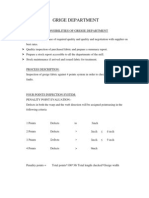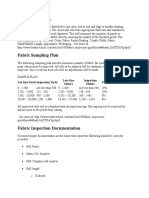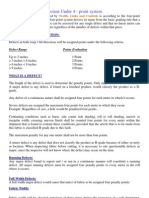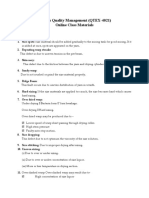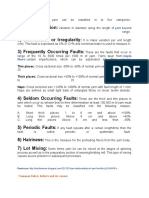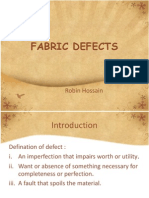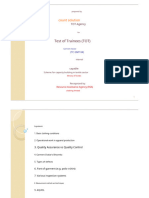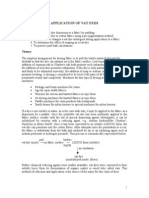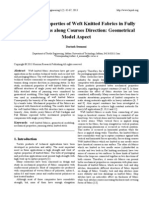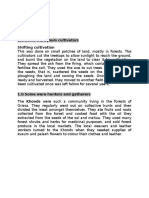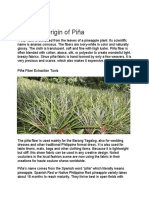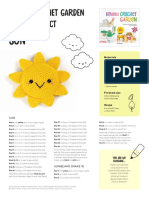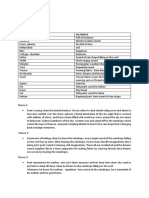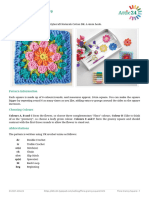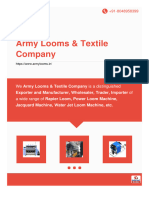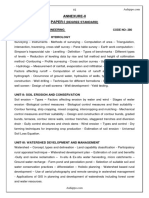Quality & Inspection
Woven Fabric Formation
Lecture 29
Quality Control
Yarn & Fabric Faults, Inspection & Folding
Yarn Faults Following faults cause problems on loom and are noted in the quality assurance forms. 1. 2. 3. 4. Gucha: If any extra thread combines with a weft thread. Sloughing off is also known as gucha. Bad Sizing: If sizing is excessive the yarn becomes stiff. There is also a possibility of joining of two or more threads. Lapaita: Ribboning is termed as lapaita. It is a winding fault in which the yarns are laid on previous layer and form ridges. These ribbons cause sloughing in weft cone. No Tail: The weft thread is made to protrude from the cone at the beginning of winding, so that it may be joined with the head of the subsequent cone. This allows a continuous supply of weft. If the tail is not made, it is noted as a fault.
FINISHED GOODS 1. Cloudy Fabric: If the let off motion is not working properly then sometimes more yarn and sometimes less yarn is released resulting in a cloudy effect due to irregular weft density. 2. 3. 4. 5. 6. 7. 8. 9. 10. 11. 12. 13. 14. 15. Bright Picks or Shiners: If the weft tensioner gives excessive tension to some picks, they will become comparatively shiny. The effect is prominent in the filament yarns. Miss Pick & Miss End: The fault is produced when the weft stop motion or the warp stop motion fails to work. The fault may occur if the head and tail of the two subsequent cones are not joined. Double Pick: If the pick finding device is not activated or the worker does not remove a faulty pick before restarting the machine a double pick is inserted. Half Pick: The fault occurs when a pick is broken and is not removed. Floats: These are those threads which do not follow the design pattern and remain out in the form of floats. This happens when the shedding is improper. Crack: If a warp thread is broken and is not checked, it may entangle with other warp threads. This results into breakage of a number of threads causing a serious fault known as crack. Reed Marks: If the dents of the reed are not in alignment they will leave a mark on the fabric while beating up. The marks continue throughout the length of the fabric and are also visible after dyeing and finishing. Temple Marks: These marks occur intermittently if either the temple cover is not properly adjusted or the temple rings are jammed. Temple Cut: If the temple rings are not suitable according to the fabric quality they might cut the threads. Rust Marks: This mark is generally not found in the air jet looms as there is no metallic picking agency. Oil Spots: Oiling is necessary for every machine. This oiling may cause spots on the fabric in case of rough handling or worn out parts. Snarling Effect: This is an accumulator fault. It is either due to low tension or due to extra winding of the yarn. The weft tends to form snarls. Torn Selvedge: If the let off tension becomes very high and is not checked, the fabric is torn. Torsion Effect: It happens when the let off is not synchronized with the take up and the amount of yarn release is not regular. The cloth tends to run away from the temples in this case. The fault may result into the severe damage of the fabric or the spikes of the temple. Sizing Spot: These are brown marks and cant be corrected. Oil Spot
16. 17.
Page 1 of 3
�Quality & Inspection
Woven Fabric Formation
18. 19. 20.
Fluff Spot: The fluff may be accumulated on the fabric along with dirt and dust. It causes a black spot on the fabric which is easily removable. Loose Selvedge: This fault occurs due to tension variation and is generally acceptable. Faulty Selvedge: If the selvedge is very loose or there is some other damage in the selvedge.
Typical Inspection& Folding There is a complete folding department, which has all the facilities for the checking, mending, sewing, packing and storing of the fabrics produced. The cloth is obtained from the looms in the form of rolls. The first step in the folding department is to weigh these rolls. The weight of the cloth roller is subtracted and the average weight per meter of the fabric is worked out. Then the roll is placed behind the folding machine and cloth is pulled over the guide rollers to the front of the machine on the screen. Now a worker carefully examines the cloth for all the faults mentioned above and records the points on a sheet. The final average points are calculated as per below table:
INSPECTION AND GRADING STANDARDS 4 POINTS SYSTEM MAJOR & MINOR PENALTY POINTS PENALTY POINTS DEFACTS IN THE WARP EXCEPT HOLES, TORN DEFACTS IN THE WEFT EXCEPT HOLES, TORN 1 UP TO 3" 2 3" - 6" 3 6" - 9" 4 9" - 36"
UP TO 3"
3" - 6"
6" - 9"
9" - 12"
CUTTING FAULTS
HOLES & TEAR 1/4" AND OVER CRACKS / OPEN SET MARK HAVING NO PICKS = 1/4" AND OVER 1/4" TOTAL PENALTY POINTS*100*36 PIECE LENGTH(YDS)*WIDTH OF PIECE(INCH)
HOLE OR TORN
POINTS PER 100 SQUARE YARDS.
FAULTS PER 100 SQUARE YARDS COTTON GREIGE FABRICS AND OTHERS CLOTH WIDTH POINTS / 100 SQ. YD.
47.5" - 51" 42 - 45
59" - 63" 52 - 56
67" - 69" 59 - 61
72" - 108" 64 - 96
118" 120" 104 106
If a piece has more than faults that are allowed it is termed as B grade. If the faults are concentrated at a certain area, that much fabric might be cut and removed, otherwise whole piece is termed B-grade. Any piece which is below packing limits is termed C grade and a piece between 1 9 meters is called CP (Cut Piece).
Page 2 of 3
�Quality & Inspection
Woven Fabric Formation
After the completion of checking procedure the cloth is rolled on paper tubes which are lighter in weight & low in price as compared to any other material but can withstand sufficient pressure. These are now enveloped in polythene sheets and then enclosed in polypropylene. At times bales are also produced instead of rolls after pressing the fabric. Generally, a roll or bale will have following marking. Roll/Bale No. Quality Pcs Mtrs Gross Wt. Net Wt.1 S. No. (Helpful for shed use only) (Helpful for Buyers)
A packing slip might also be prepared as below: PACKING SLIP DATE BALE NO. DAY Total Pieces QUALITY MONTH Gross W.Kgs. Net W.Kgs. MTRS. S. NO. Bale Clerk Checking Clerk YEAR
One copy is placed in the roll or bale, one is kept for Excise department and one is kept in the shed record. The packing of the towels in this manner completes the task of the staff in respect of towel production. Now the rolls and bails are orderly placed in the department at fixed places and the export office is informed about the material produced. The export office contacts the container at appropriate times and these rolls and bales are removed from the department. These containers are then sent to end customers.
Net weight = Gross weight - Paper tube weight Page 3 of 3


















